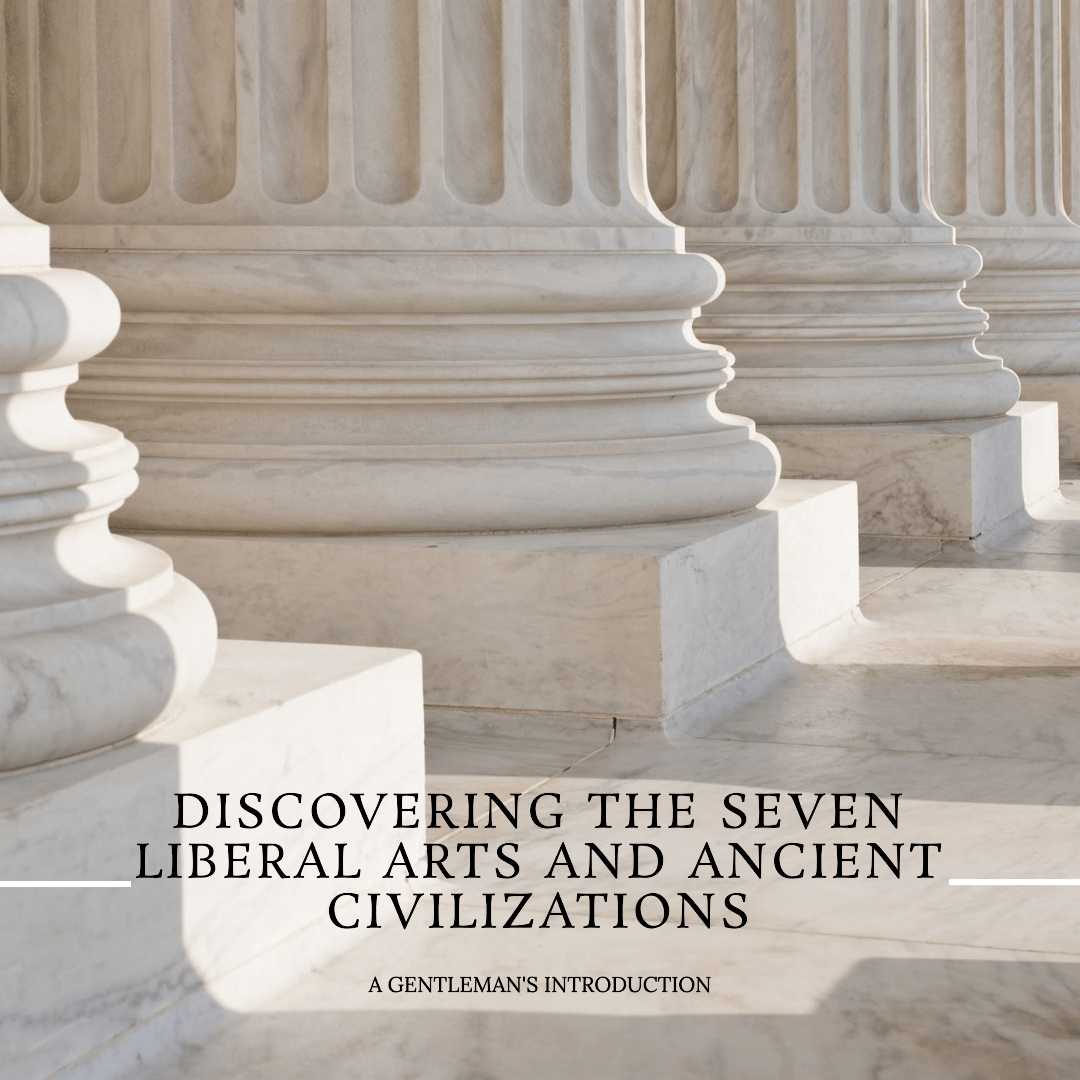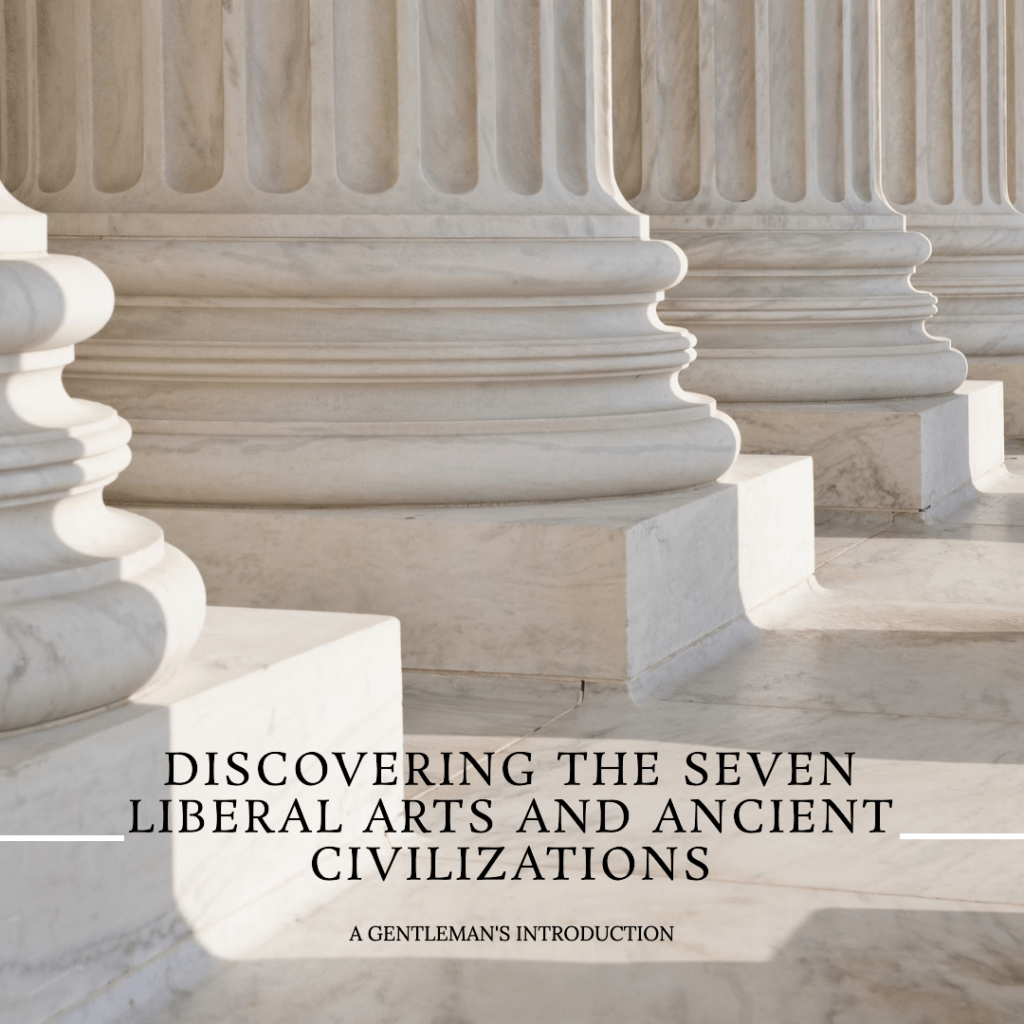
The civilizations of ancient Greece and Rome were eras marked by significant cultural progress and innovation. More than two millennia ago, these societies established an educational framework that endured up until the 20th century. This system, known as the liberal arts, encompassed the fundamental knowledge necessary for a free individual (derived from the Latin term liberalis, meaning “befitting a free person”) to participate effectively in society.
The value of a liberal arts education has been recognized from the era preceding the birth of Christ up to the dawn of the 20th century. Despite the challenges facing modern democracy, which seems less effective when compared to the ideal of a benevolent monarchy, there remains a belief that democracy could be viable with an educated citizenry. The liberal arts curriculum aimed to provide this foundational education, covering seven distinct areas of study, which we will explore briefly.

The concept of the liberal arts dates back to Plato, who detailed them extensively in his seminal work, “The Republic.” Plato’s most distinguished pupil, Aristotle, believed that a well-educated individual should be able to fully explore and analyze any idea or concept without prematurely accepting or rejecting it. Seneca the Younger, a Stoic philosopher of Rome who served as an advisor to Emperor Nero from 4 BC to 65 AD, was a fervent proponent of the liberal arts.
The Stoic philosophy, established in the 3rd century BC in Athens, championed a logical approach to life. It taught that negative emotions are the result of flawed judgments and reasoning, emphasizing the importance of aligning one’s will with nature and prioritizing actions over words. According to Stoicism, logic is crucial for success, and virtue is defined as a will in harmony with nature. In dealing with others, it advocated for freedom from anger, envy, and jealousy.
In Hellenistic Greece, the liberal arts were highly valued and known as “enkuklios paideia,” or “education in a circle.” They encompassed four scientific arts—music, arithmetic, geometry, and astronomy—and three humanities—grammar, logic, and rhetoric. These subjects were categorized into two groups: the Trivium, which included the three humanities and served as the foundation for understanding sensory perceptions, and the Quadrivium, which comprised the four scientific arts.
Together, these seven liberal arts formed the cornerstone of education, equipping students with critical thinking skills. Those aiming for specialization in fields like medicine, architecture, philosophy, or theology would first ground themselves in the liberal arts before advancing to their specific areas of interest.
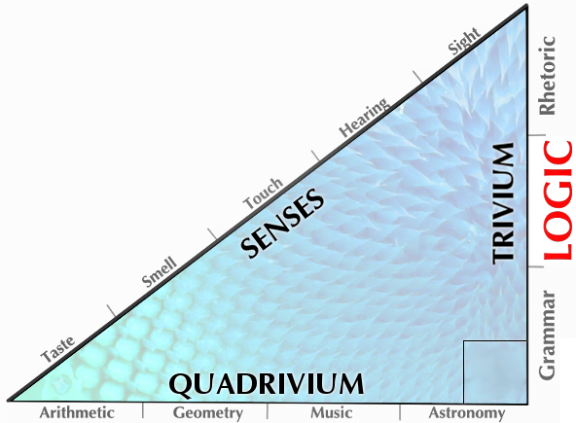
The fundamental objective of engaging with the arts lies in honing the mind’s capacity for critical thinking, rather than merely instructing it on the contents to think about. This approach fosters a method of inquiry and analysis that equips an individual to navigate complex ideas and differentiate between what is real and what is not. When we intertwine the principles of the seven liberal arts—encompassing a broad spectrum of human knowledge and skills—with the sensory experiences provided by our five senses, we enable a deeper understanding and discernment of our surroundings. This conceptual framework of blending theoretical knowledge with empirical experience can be symbolically represented through the structure of a Pythagorean triangle, illustrating the harmonious balance between abstract thought and tangible perception.
The Humanities (The Trivium)
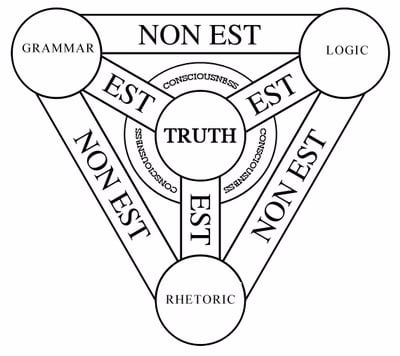
The Trivium, deriving its name from the Latin for “the meeting place of three roads,” constitutes the foundational trio of subjects that form the core of classical education, preceding the study of the Quadrivium. This term has also given rise to the word “trivia,” reflecting its origins in the threefold path of learning: tri (three) and via (road). Comprising General Grammar, Formal Logic, and Rhetoric, the Trivium lays the essential groundwork for all further scholarly pursuits. Despite being considered less complex than the subjects encompassed within the Quadrivium, it’s often found that errors in logical thinking and reasoning stem from an insufficient grasp of these foundational areas.
Grammar serves as the mechanism for collecting and categorizing the sensory input from the world around us into an organized and coherent framework of knowledge. It encompasses the rules and structure of language, enabling the precise identification and articulation of observations and ideas.
Logic, or Dialectic, is concerned with the process of rational thought and the analysis of arguments. It involves the identification and correction of erroneous reasoning and the elimination of inconsistencies in thought, ensuring that conclusions are soundly based on their premises.
Rhetoric, also referred to as the art of Wisdom, involves the skillful use of language to inform, persuade, and motivate others. It represents the culmination of the lessons of Grammar and Logic, employing language as a tool to effectively communicate ideas and sway opinions.
| [1] General Grammar | [2] Formal Logic | [3] Classical Rhetoric |
|---|---|---|
| Answers the question of the Who, What, Where, and the When of a subject. | Answers the Why of a subject. | Provides the How of a subject. |
| Discovering and ordering facts of reality comprises basic, systematic knowledge. | Developing the faculty of reason in establishing valid [i.e., non-contradictory] relationships among facts is systematic understanding. | Applying knowledge and understanding expressively comprises wisdom or, in other words, it is systematically useable knowledge and understanding. |
The Scientific Arts (The Quadrivium)
The scientific arts include music, arithmetic, geometry, and astronomy. After learning the basic skills of the Trivium, which are applicable to all other studies, the scientific arts known as the Quadrivium would be studied. The Quadrivium “place where four roads meet” include arithmetic, geometry, music, and astronomy.
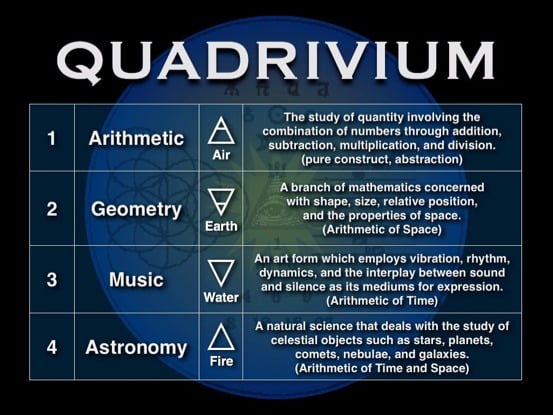
Arithmetic delves into the realm of numbers, an ethereal concept that exists independently of physical constraints such as space and time. It is a discipline centered on the exploration of quantities, serving as a fundamental pillar in understanding the abstract principles that govern the universe. Arithmetic allows us to quantify the world around us, providing a framework for the systematic study of numbers and their relationships, operations, patterns, and structures. Through arithmetic, we develop the ability to analyze and manipulate numerical data, laying the groundwork for more complex mathematical and scientific inquiries.
Geometry, on the other hand, situates numbers within the context of space, focusing on the properties and relations of points, lines, surfaces, and solids. It is the mathematical study of shapes and their configurations, examining how sizes, distances, angles, and dimensions interact to form the physical world. Geometry bridges the abstract with the concrete, offering a visual language for understanding and interpreting the spatial organization of objects. By exploring the principles of geometry, we gain insights into the nature of physical space and the geometric structures that underlie the visible world.
Music translates numbers into the dimension of time, employing the mathematical theory of numbers to articulate the intricate relationships between sounds. It is the art and science of organizing tones or sounds in succession, in combination, and in temporal relationships to produce a composition having unity and continuity. Music harnesses the numerical relationships between intervals and rhythms to create harmony, melody, and rhythm, weaving a tapestry of auditory experience that transcends cultural and linguistic barriers. Through the lens of music, we perceive the beauty and complexity of sound as it unfolds over time, revealing the profound connections between mathematics, art, and human emotion.
Astronomy expands the application of numbers to encompass both space and time, offering a comprehensive study of celestial bodies and their movements. It is the scientific study of the stars, planets, comets, galaxies, and the cosmos as a whole, seeking to understand the vastness and dynamism of the universe. Astronomy combines geometric models with temporal measurements to map the heavens, track celestial events, and probe the mysteries of the cosmos. This discipline illuminates the fundamental laws that govern the movement and evolution of celestial bodies, providing a grand perspective on the interconnectedness of space, time, and matter. Through the study of astronomy, we delve into the origins, structure, and ultimate fate of the universe, connecting our earthly existence to the broader cosmos.
The Seven Combined
Grammar = Knowledge = What?
Logic = Reason = Why?
Rhetoric = Communication = How?
Arithmetic = Formal = Do
Geometry = Visual = See
Music = Artistic = Feel
Astronomy= Exploration = Seek
By developing these basic skills, men would have the basic tools they needed to live a fulfilling and satisfying life and to explore their emotions, dreams, ambitions, and desires.
Two Thousand Years Of Liberal Arts
In ancient Greece, all free men were expected to obtain a basic liberal arts education. Women received a limited public education which focused on physical fitness, how to sing, dance and play instruments. These were not seen as “childish endeavours” but indeed a strict and formal education system was established that provided a complimentary, but important role in society, a foil to the men who were trained in logic and reason.
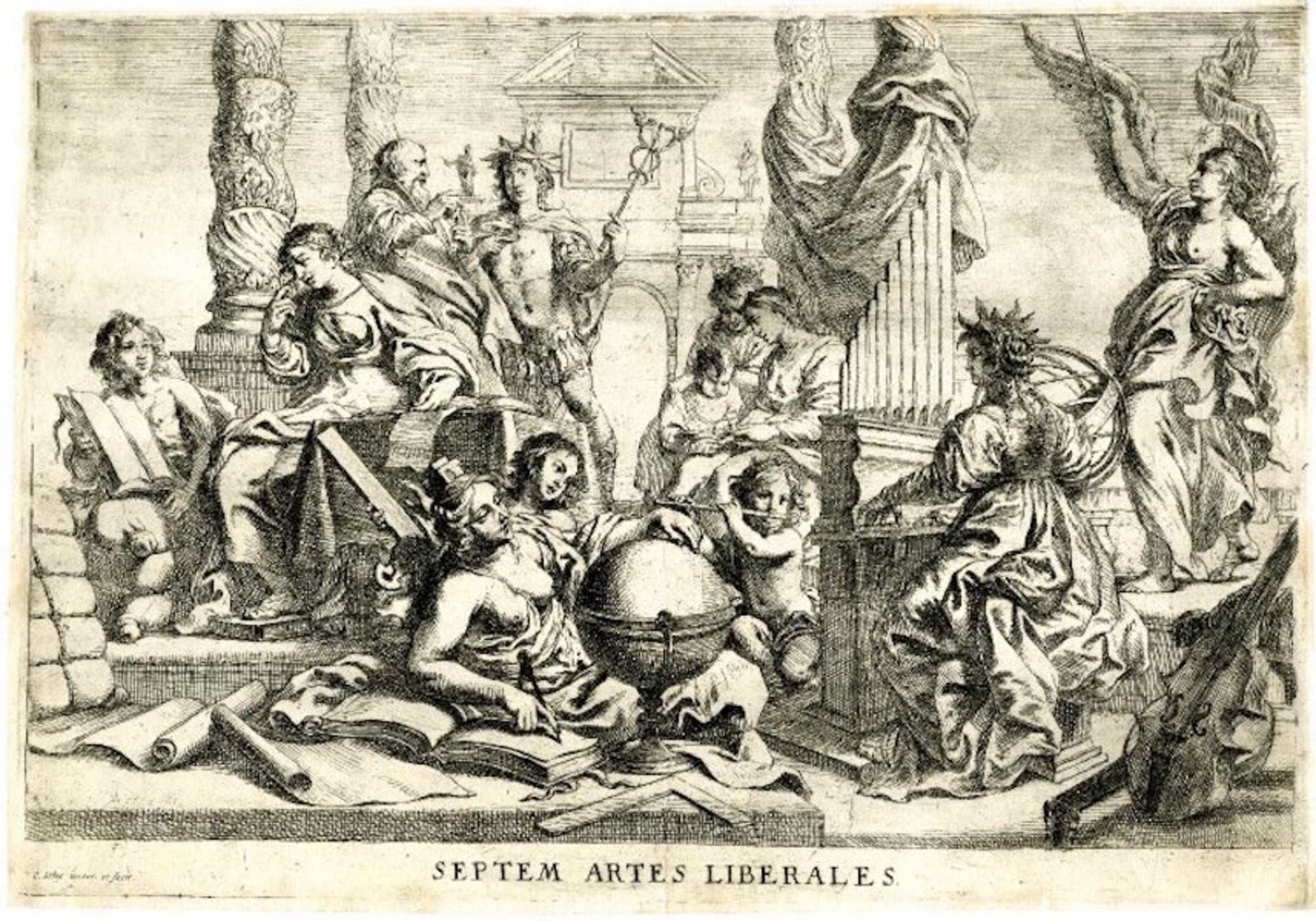
During the 17th and 18th centuries, an ambitious endeavor was undertaken to compile the sum of human knowledge into comprehensive collections known as “encyclopedias,” a term deriving from the Greek words for “complete instruction” or “complete knowledge.” This period marked a significant milestone in the pursuit of learning, reflecting an era’s dedication to the organization and dissemination of information across various fields of study.
The concept of the seven liberal arts, embodying essential domains of knowledge, has been embraced by nearly every major civilization over the last two millennia. These arts have served as the bedrock of a well-rounded education, emphasizing the development of critical thinking, effective communication, and analytical skills. The significance of these arts transcends mere academic pursuit; they have been interwoven into the cultural and intellectual fabric of societies, influencing various institutions and movements.
One notable example of the influence of the seven liberal arts is found within the traditions of Freemasonry. The Fellowcraft Degree, a key stage in the journey of a Freemason, explicitly encourages the study of these arts. Freemasonry, a fraternal organization with deep historical roots and a rich symbolic system, places a high value on the principles of knowledge, morality, and brotherly love. The seven liberal arts are esteemed within Freemasonry not only for their educational value but also for their role in shaping the moral and ethical framework of its members. The teachings and practices of Freemasonry are imbued with the ideals found in the liberal arts, advocating for personal growth, intellectual development, and a commitment to the betterment of society.
The enduring legacy of the seven liberal arts, from their classical origins to their incorporation into modern institutions like Freemasonry, underscores their universal appeal and timeless relevance. By fostering a comprehensive understanding of the world and our place within it, the liberal arts continue to serve as a cornerstone of cultural and intellectual advancement.
